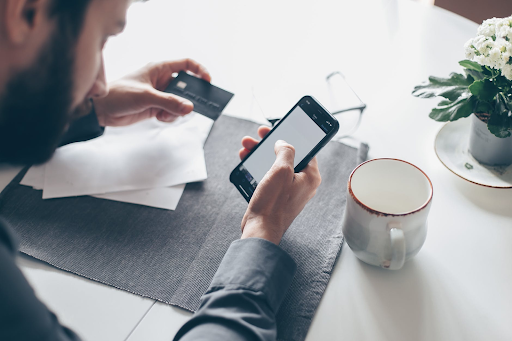
As mobile users become more sophisticated, so must a banking app. In today’s market, there is no room for a mediocre app. In fact, customers expect a full-featured mobile experience. These are nine must-have features for your app if you want to stay on the leading edge of customer expectations.
Never miss a bill, see who’s paid you, and get instant notifications for pending or new payments. I bet this sounds familiar to you. These are just some of the reasons why we love banking apps. They’re convenient, simple, and easy to use. With a few taps on the phone, it opens up a world of banking possibilities and opportunities. You can do just about anything: deposit checks, transfer funds, check balances, and more.
FICO’s latest statistics (no doubt accelerated by the Covid-19 pandemic) show that banking trends are moving more than 70% of Australians away from the age-old tradition of walking into a brick-and-mortar bank to carry out their transaction, and this number will only increase year by year.
As a result, there has never been a better time to create an app for your bank. But, it’s no secret that developing a mobile app is serious business. Making sure your app works properly, is attractive, and has everything your users could want requires expertise, skill, and planning.
So, if you have just started out with a banking app, are thinking about making your own or need to get your banking app updated, you need to understand what customers are looking for when it comes to their bank’s app.
The most important thing is that your app should be compatible with all devices and operating systems. If people have problems downloading your app, logging in, and using it, they’re going to uninstall it and move on. For more information check this blog post – How to Build a Top-Notch Mobile Banking App
Assuming you’ve solved the compatibility and performance issue, here are a few features that take it from meh to WOW.
Here’s the recipe for an awesome banking app
Best in market security and fraud protection
The best banking app has to be ultra-secure as sensitive financial data is processed regularly. For the ultimate level of security, it is important to implement stringent authentication and take advantage of security layers built into the app.
However, the key is to strike the right balance between security and usability. An app that’s too cautious can frustrate users; one that’s too easy might leave security holes.
Multi-factor authentication, for example, is a strong security measure, but it comes at the cost of convenience. Given a choice, most people would prefer to easily log on to their bank app, making this feature a poor fit for the banking sector.
Alternatively, biometric authentication is the fastest and most dependable way to screen a person’s identity. The technology checks physical metrics, including touch, voice, and physical anatomical features.
An example is Wells Fargo’s Eyeprint ID. To ensure increased security, customers can log into their online banking by simply looking into their smartphone camera. A game-changing feature, the Computer Eye scans the blood vessel patterns of the eyes and matches them to their online banking profile – eliminating the need for usernames, passwords, corporate ID numbers, and security tokens.
Biometric authentication is a dual advantage app solution. Wherein it can be used to guarantee the user’s identity, the method also makes your mobile banking application more personalised!
Another important consideration is fraud protection. Incorporate multiple layers of protection against fraud to make it harder than ever to impersonate the identity of users.
Keep the following in mind:
- Keep all passwords or pins stored safely and securely, either via encryption or hashing. Also, never store them in the source code itself but on an external server.
- Adding email/SMS confirmation to the login is a good idea.
- Start fresh with each new session.
- Restrict login attempts.
Bank Account Management Capabilities
It’s not enough to just check your bank balance and make a bank payment using a mobile app. Banks need to offer their customers other capabilities that are truly valuable.
Linked Accounts: If you have multiple accounts at the same bank — savings, checking, credit cards — the app should be able to give you access to all of them. Ideally, you should be able to view balances and move money around between accounts with just a few taps.
Notifications: It’s hard enough keeping track of bills when they’re right in front of you. When they’re scattered across multiple accounts, it’s even harder. Successful banking apps should be able to send push notifications about upcoming charges or payments. That way, customers can keep an eye on what’s coming up and address any problems before they become big problems.
Goal setting: People want to be able to save money as easily as possible. Whether they want to save up for an upcoming vacation or pay down credit card debt, your users can access all of the tools they need right from your app without having to hunt around for them in a different system. If you enable users to set savings goals and see their progress towards those goals directly in your app, you’ll give them the convenient way to save that they’ve been searching for.
Take it a step further with automated savings plans – the feature gives account owners access to a safe and convenient way to put away money regularly into a savings plan.
Budgeting: Typically, this will allow bank app users to set budgets for different categories such as shopping, dining out or entertainment to track their overall spending. They also offer the ability to add notes for each transaction to explain why you bought a particular item and how much it cost. More advanced settings will also let users set spending limits per month or week. For each category, owners get a clear picture of how much is available to spend and how much they’ve already spent. It can be colour-coded, too, so they know at a glance which categories are over or under budget. And if they go over budget in any category, the app sends you a helpful notification so that you can stop the bleeding before it becomes a problem. Adding this feature can help customers identify areas where they could cut spending without hurting their lifestyle too much.
Scheduling: Users should be able to schedule transactions for different dates, such as monthly bills or savings transfers. This feature helps keep transactions organised so that users don’t have to worry about going through inconvenient times or on the wrong day of the month.
Comprehensive Banking Services
To meet customer needs and provide full service, your banking app should allow users access to comprehensive banking services.
Standard banking features, i.e. account balance, transaction history and payments, are a must-have on any banking app. However, these don’t seem like much to write home about. How can you add an extra layer and make it exciting?
The answer is by adding a few bells and whistles to your standard features. These can be anything from letting users set up push notifications for account alerts to sending them details of their credit card rewards points.
The best banks apps also make it easy to find what you are looking for. The app should be able to suggest potential search terms if you type in a few characters.
Bill Pay: With bill pay, you can pay your bills on the go. You may need to verify your identity to use bill pay.
Request Money: Send a request for money to friends and family or even coworkers so they can pay you back from their bank accounts. When you request money, you can also opt in to get a reminder of when your loan is due.
Add beneficiaries: The app should allow you to view and edit any payments scheduled for future dates. It should also let you add new beneficiaries who aren’t already listed in the app.
Branch/ATM Locator:
You’ve probably been in a situation where you want to visit a branch or ATM, but you’re not sure which one is closest – this can be inconvenient.
The bank is the online equivalent of the neighbourhood convenience store. It’s where people run in to grab a quick transaction, whether it’s transferring money or withdrawing cash from an ATM. Branch/ATM locator service is a nice-to-have for banking apps. It shows users what branches and ATMs are around them, even if they don’t bank with that institution.
The branch/ATM locator feature would allow customers to find their nearest branch or ATM and its address fast. This feature is useful for banking app users who want to avoid banking charges, especially those in areas with few ATMs or branches.
This feature could also be used to anticipate customer needs.
Peer-to-Peer ( P2P) payment
Peer-to-peer payment apps like Venmo and Zelle have been on the rise in popularity lately. These apps are great for splitting checks, paying back friends and family or even paying your rent. However, using these 3rd party providers come at a price – inconvenience and security. Providing this feature with your app solves that and also enables your bank to retain their customer.
Implementing a secure P2P service to your app will entice customers because they do not have to leave your platform to complete a crucial banking task. Instead, they can complete the process from one location and maintain security in doing so.
QR Code Payments
The idea of paying through a phone may sound kind of silly, but what if you’re in a hurry and don’t have time to wait for the cashier to accept your check? Or what about if you’re in a store and don’t have cash on hand to buy something? You could use a credit card, but that would require pulling out your wallet and finding your card.
We’ve all been there before, so it’s no surprise that an increasing number of people said that they wanted QR code payments within their banking app.
Many people still don’t know what they are, so let’s clear it up.
A QR code is a matrix (or 2-dimensional) barcode that stores information such as text, numbers and even pictures.
QR stands for “quick response”. This is because it is designed to allow its contents to be decoded at high speed.
When done right, QR code payments can be a great way to quickly move funds between accounts or pay someone back in person.
AI-assisted chatbots
If you’ve ever tried calling your bank’s helpline, you know that the wait times are painful. Chatbots can reduce service costs by up to 30% and offer fast response times and the ability to resolve simple requests.
Chatbots allow customers to communicate directly with their bank through a messaging interface through AI and machine learning technology. Users love this approach because it’s fast and convenient; they can ask their questions when convenient and receive quick information back.
Also, some would prefer a chatbot to solve their problems than the company’s customer service team. Why? Let’s face it, speaking to a human on the phone can be a nightmare sometimes.
Chatbots make life easier for customers and provide additional ways for you to reach them. They deliver useful information and answer questions that people might have about your brand, products or services. And they do it 24/7.
And, if your chatbot can solve the user’s problem without being transferred to an agent, this will increase your interactions with customers and potentially improve your customer rating scores.
Deposit scanning
Well, technology marches on. And with it comes new ways to deliver banking services.
Tapping into this trend, banks are developing apps that make life easier for customers by offering them quick and easy ways to handle financial tasks from their phone, like making a mobile payment or depositing checks.
Users want an easy way to deposit checks by taking pictures of each check with their smartphone cameras and uploading them directly into their accounts. Banks that offer these convenient features can increase their user base and bring in more business.
This is really a cool feature many banks are starting to offer. The app can recognise the check you’re trying to deposit, so you can snap a picture of it with your smartphone and upload it for deposit. No more trips to the bank!
Voice-Activated Payments and Virtual Assistants
Tying into virtual assistants like Amazon Alexa, voice-assisted technology will become more widely used. They’ll help users avoid typing in a long card number while making purchases and will allow them to check their bank accounts with just a few spoken words.
An increasingly popular payment method, voice-activated payments, let you make purchases with just the sound of your voice. While it’s not widely supported yet, it is still a feature many people are looking for in a banking app.
Voice-activated virtual assistants are what they sound like — they allow you to speak a command into your phone and receive a reply or action immediately afterwards. They’re incredibly useful for banking because they allow you to keep your hands free while you do other things. For example, when you’re driving home from work, you can ask your virtual assistant how much money is in your checking account. It will then respond with the answer and tell you whether or not there are any issues with this account (i.e., whether or not there are sufficient funds). It will allow you to stay focused on the road without having to take your eyes off the road or look at your phone screen.
Conclusion
To sum up, a successful app from a banking company must address four main areas of functionality: security, ease of account management, mobile accessibility and payment options. The mobile market is cutthroat, which means banks have to keep their promises to users or risk losing their business. If you’re banking on an app for your financial organisation, keep these nine must-have features in mind. Your customers need them!






